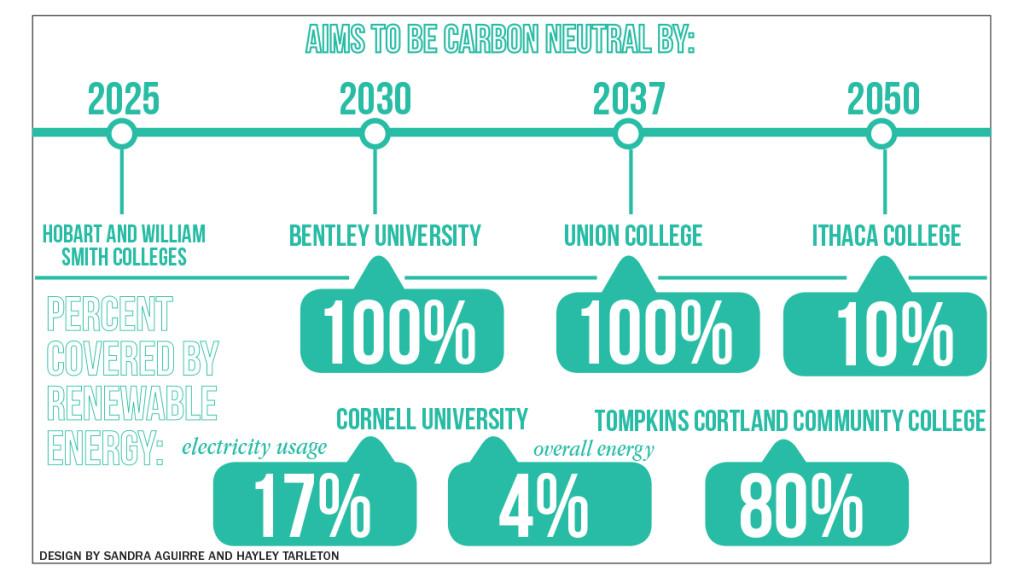Ithaca College is still behind on using renewable energy compared to other colleges and universities nationally, despite its recent adoption of solar energy to cover 10 percent of the college’s energy needs.
In 2007, then-President Peggy Ryan Williams signed the American College & University Presidents’ Climate Commitment. With the agreement, the college developed the Climate Action Plan, pledging to be carbon neutral by 2050. The college has fallen short on many aspects of the plan.
On Feb. 19, the college announced an off-campus solar electric project in which it would purchase all of the energy produced in a power purchase agreement with Borrego Solar Systems Inc. The solar project is the only form of renewable energy used on campus, aside from a geothermal heating system that solely provides for the Peggy Ryan Williams Center.
Despite the progress made with this solar project, when comparing the college’s 10 percent to numerous other colleges‘ and universities‘, the college does not measure up.
Some colleges and universities are covering all — and even more than — their energy needs by renewable sources, such as Union College, which pledged to be carbon neutral by 2037; Bentley University, which pledged to be carbon neutral by 2030; and Hobart and William Smith Colleges, which pledged to be carbon neutral by 2025.
The Environmental Protection Agency released a list of 30 colleges and universities in the U.S. that have the highest green power usage. Among these 30 schools was Union, located in Schenectady, New York, which covers 100 percent of its energy needs with renewable energy.
According to Meghan Haley-Quigley, sustainability coordinator at Union, the campus has four solar arrays; three vertical–access wind turbines, a turbine with blades arranged vertically that turns via wind to generate power; a solar–thermal hot water system, a system that uses the sun’s energy to heat water; and two geothermal heating and cooling systems, which use the natural heat in the earth to create energy to heat and cool buildings. Although Union has invested a great deal in these on-campus renewable energy sites, this only accounts for less than 1 percent of the total energy consumed by the college, Haley-Quigley said.
Haley-Quigley said that while all forms of renewable energy go into the calculator the same way, some are preferable to others.
“There’s a hierarchy of what’s environmentally preferable,” Haley-Quigley said. “Number one would be on–site production. Number two would be an off–site solar farm via ppa or a lease. Number three would be the purchase of RECs.”
Additionally, Bentley University, located in Waltham, Massachusetts, covers 100 percent of its energy needs with renewable sources. This energy also comes from the purchase of renewable energy certificates from wind–power sites in Texas and Nebraska, said Amanda King, the director of sustainability and special adviser to the president at Bentley. With the purchase of these energy certificates and reductions on campus, King said, Bentley has reduced its carbon net emissions by 50 percent.
Outside the EPA’s list, Quinnipiac University, a member of the New American Colleges and Universities group — a peer group of colleges comparable to Ithaca College — produces green energy on–site, like Ithaca College. Keith Woodward, associate vice president for facilities operations at Quinnipiac, said via email the university began using renewable energy in 2007 and produces 30 million kilowatt hours of renewable energy a year from 721 solar panels and 40 geothermal wells on campus.
Locally, Tompkins Cortland Community College installed an off-site solar farm that went into use around July 1, 2015, said James Turner, director of facilities at TC3. Turner said he estimates the array will cover 80 percent of the college’s energy needs. Also local, Courtney Koelbel, project manager of Cornell University’s Campus Sustainability Office, said 17 percent of its electricity usage and 4 percent of its overall energy come from carbon-free sources.
Jerone Gagliano, director of energy management and sustainability at Ithaca College, said via email the current goal of the college is to complete a sustainability strategic plan this year. Gagliano said he believes the college is on track to be carbon neutral by 2050, given “strategies and technologies that exist today.”
According to Gagliano, the college will also sign on to be a green power partner with the EPA once the solar array is completed and producing energy. The green power partners are organizations that use renewable energy and, therefore, help protect the environment. Green power partners are what make up the EPA’s top 30 colleges and universities when it comes to renewable energy.
Paula Turkon, assistant professor of environmental studies and science at Ithaca College, said the solar array project is a great way to begin. Turkon said she believes the college used to be more invested in sustainability, but things are picking up again.
“I think things are ramping up,” Turkon said. “For the first time in a couple of years, I’m much more optimistic.”







